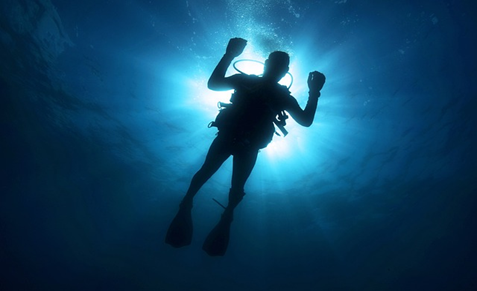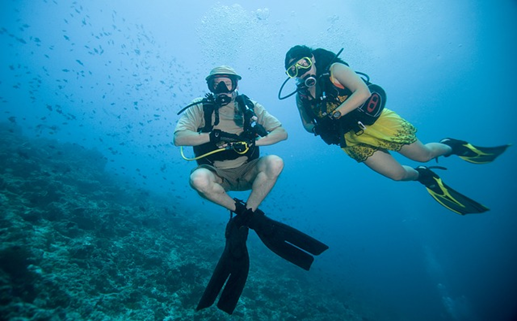David C. Mulhauser is a seasoned scuba diver and avid photographer who enjoys capturing the beauty beneath the waves. In the following article, David Mulhauser shares ten indispensable tips to help others master the art of underwater photography and bring the depths to vivid light.
Beneath the tranquil surface of the world’s oceans and bodies of water lies a mesmerizing realm waiting to be captured – the enchanting world of underwater photography. It’s a realm where the rules of conventional photography are rewritten, and a photographer’s canvas transforms into a liquid dreamscape, filled with vibrant marine life, breathtaking landscapes, and the play of light in an entirely different medium. Mastering the art of underwater photography is a thrilling and challenging journey, where the fusion of creativity, technical skill, and a deep appreciation for the aquatic world comes together to produce awe-inspiring images.
In this article, David Mulhauser dives into ten essential tips that will help navigate the intricacies of underwater photography. Whether you’re a beginner or a seasoned pro, these insights will help you take your underwater photography to the next level.
Skill Level
The art of underwater photography presents a myriad of challenges demanding both physical and technical skills. The environment is demanding, and underwater photographers must deal with limited visibility, and ensure their own safety while they work. Handling specialized equipment underwater and understanding lighting techniques further add to the complexities.
This blend of physical, financial, and technical challenges makes underwater photography an art form that demands dedication, skill, and patience from an underwater photographer.
David Mulhauser on Choosing the Right Camera and Equipment
To create stunning underwater images, David C. Mulhauser says that it’s essential to choose the right camera and equipment.
Types of Cameras: DSLR vs. Compact Cameras
DSLR cameras boast larger sensors and superior image quality, making them ideal for professionals seeking more control and versatility. However, they are heavier and more expensive than their compact counterparts.
Compact cameras, on the other hand, are more affordable and easier to handle, making them suitable for beginners or casual photographers. Despite their convenience, compact cameras offer limited manual controls and produce images of lower quality compared to DSLR cameras.
Underwater Housings
David Mulhauser notes that it is vital to invest in high-quality underwater camera housing to safeguard your camera from water and pressure. If you’re new to undersea photo exploration, consider renting gear or starting with a GoPro to test the waters before committing to a pricier setup.
Strobes and Lights
Artificial lighting is crucial to combat the loss of natural light underwater. Strobes and underwater lights illuminate your subjects, bringing out vibrant colors and details in your photos. Experimenting with strobe positioning and lighting techniques can help you create captivating underwater images that truly stand out.
Filters
Filters can correct color distortion and enhance your images. Consider using color-correction filters to restore the natural colors that water absorbs and polarizing filters to reduce reflections and enhance contrast.
Mastering Lighting Techniques Underwater

Understanding how light behaves underwater is essential for creating striking photos. The loss of color and contrast due to water’s filtering effect means you’ll need to master artificial lighting and positioning your strobes effectively. In addition to strobe positioning, harnessing the power of natural light can greatly enhance your underwater photos.
Choosing the Right Lens
Your choice of lens can significantly impact the composition and quality of your underwater images.
Wide-angle lenses
These are great for capturing expansive scenes and large subjects, making them ideal for shots of coral reefs and schools of fish. Attaining focus with wide-angle lenses can be challenging, necessitating practice and refinement of your skills for sharp and vivid images.
Telephoto lenses
David Mulhauser says that telephoto lenses are designed for getting close-up shots of shy or fast-moving marine life. They offer a longer reach, allowing you to capture subjects that might be difficult to approach.
Macro lenses
Perfect for capturing the intricate details of smaller underwater creatures, such as nudibranchs and tiny critters. It’s designed for extreme close-up shots, capturing the details of small subjects.
Camera Settings and Techniques
Achieving proficiency in camera settings, namely shutter speed, aperture, and ISO, is vital for capturing exquisite underwater images.
Shutter Speed
David C. Mulhauser explains that mastering your shutter speed is crucial for taking compelling underwater photos. Use fast shutter speeds to freeze fast-moving subjects or experiment with slower speeds for creative effects.
Aperture and Depth of Field
Adjust your aperture for the desired depth of field, creating soft backgrounds or sharp details as needed.
Using ISO to Your Advantage
Keep your ISO as low as possible to reduce noise, only increasing it when necessary for low light conditions.
Composition and Framing
David Mulhauser says that producing attractive underwater images requires careful composition and framing. Techniques such as the rule of thirds, incorporating leading lines, and using negative space can help guide the viewer’s eye and generate a more dynamic, engaging image.
By paying close attention to the elements within the frame and following underwater photography tips, you can create underwater photos that truly captivate the viewer.
Get Close to the Subject
Approaching your subject closely is critical for enhancing clarity and color in underwater photography. Proximity to the subject allows you to minimize the amount of water between your camera and the subject, reducing color loss and increasing sharpness.
David C. Mulhauser remarks that practicing close-up photography with a camera underwater can help you capture the intricate details and vibrant colors of the underwater world.
Consider the Time of Day
The time of day profoundly influences the lighting conditions in photography, and utilizing this understanding can aid in creating breathtaking images. Here are some tips for capturing the best lighting conditions:
- Early morning light creates a serene atmosphere.
- Midday light offers excellent visibility for capturing fine details.
- Late afternoon light can produce dramatic shadows and moody imagery, adding a touch of mystery to your underwater shots.
Perfecting Buoyancy Control for Steady Shots
For underwater photography, buoyancy control is of utmost importance as it allows stability in the water, thus enabling sharp and focused images. Perfecting your buoyancy control also allows you to approach your subject without disrupting the aquatic environment, ensuring you capture the true essence of the underwater world.
Experimenting with Different Camera Settings
Trying out diverse camera settings can aid in achieving distinctive and inventive underwater images. By adjusting settings such as shutter speed, aperture, and ISO, you can create a variety of visual effects, capturing the underwater world in new and exciting ways.
David Mulhauser says, don’t be afraid to step outside your comfort zone and explore new techniques to elevate your underwater photography to new heights.
Post-Processing Techniques for Underwater Photos
Post-processing plays a crucial role in the creation of enchanting underwater photographs. It lets you adjust the colors, improve details, and make modifications to exposure and contrast. Making these small adjustments can drastically change the overall image quality.
Color Correction
Rectifying color balance in your underwater photos can bring a noticeable difference to the final outcome. Using editing software such as Adobe Lightroom or Photoshop, you can adjust white balance and fix exposure issues to ensure colors appear as natural as possible.
Contrast and Exposure Adjustments
Modifying contrast and exposure can substantially improve your underwater images, rendering colors and details more conspicuous. Using post-processing software, you can fine-tune the exposure, highlights, shadows, whites, and blacks to create a visually striking image that captures the true beauty of the underwater environment.
Sharpening and Detail Enhancement
Underwater images can appear slightly soft due to the water’s diffusing effect on light. Apply sharpening and detail enhancements to bring out the fine details of your subjects. However, be cautious not to over-sharpen, as it can introduce noise and artifacts.
Using Filters and Effects
Utilizing filters and effects on your underwater images can assist in creating distinctive and enchanting photos that distinguish themselves. From magic filters that boost colors to ND filters that enable longer exposure times, experimenting with various filters and effects can add a creative touch to your underwater photography.
David C. Mulhauser says to embrace your artistic side and explore the possibilities of filters and effects to create visually stunning underwater images.
Summary
Excelling in the art of underwater photography necessitates dedication, skill, and a profound understanding of the unique challenges and techniques involved. From choosing the right equipment and mastering lighting techniques to perfecting buoyancy control and experimenting with post-processing, these essential tips will help you capture stunning underwater images that showcase the breathtaking beauty of the aquatic realm.
Dive in, explore, and let your creativity soar as you unveil the wonders of the underwater world through scuba diving.










